Products You May Like
Capcom’s turned back the clock with Kunitsu-Gami: Path Of The Goddess, bringing to us an action RPG tower defence hybrid that’s very 2000s and very welcome in this age of open world, live service-ness. And for some, it’ll deliver what’s needed: a fairly good time. A time marked by a loop that does hack ‘n slash, management, and a dash of base repairs to an average degree. For me, though, and possibly many others, I simply don’t think this mix ever truly captures what makes even the simplest of tower defence games so captivating.
Kunitsu’s set on Mt. Kafuku, a big mountain that’s been ravaged by dribbly demons. They emerged at night over the course of however many days or weeks or months and toppled the lovely Kafuku community, who clearly hadn’t put up enough sandbags. All those lovely lakes and quiet villages? Covered in gloop mate, sorry. But! There is hope, though, as the maiden of the mountain Yoshiro has the mystical powers and the dance moves to dispel the darkness and rid the mountain of gloop once and for all. And that’s where you, a lad called Soh, must guide Yoshiro safely through the cleansing process with the powers of swordsmanship and people management.
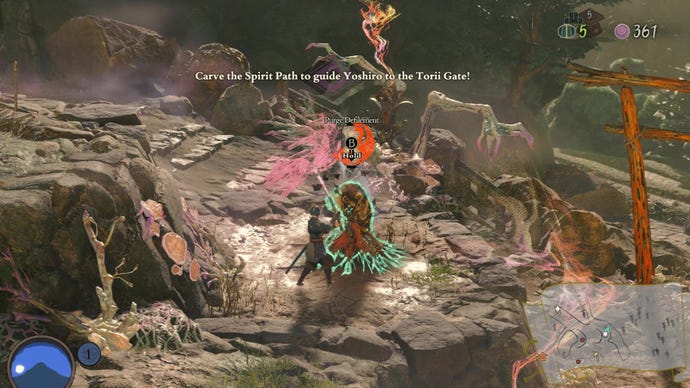
The cleansing process naturally leads you through a set of progressively difficult areas of the mountain, each split into two missions: the first is a tower defence hybrid I’ll get into in just a jiffy, while the second is a self-contained boss fight. There’s no straying from the path you’re given, so if you get stuck on a level you’ll need to find a way to beat it by using your tactical nous. Although I never had an issue with this, as the game’s relatively straightforward and gives you enough resources to level up Soh and his minions to keep up with the dribblies.
Tower defence style missions have an equally simple setup, often plopping Yoshiro on one end of the map, before tasking you with leading her safely to the Torii gate at the other end so she can dispel it. There are, of course, a couple of catches. The gates spill demons at night and Yoshiro moves at tumbleweed pace, so you can’t just hold her hand and walk her over to each gate while it’s light out. Instead, you’ll use up special orbs to carve out a path for her to follow in her own time, and that almost always means you’ll be waiting multiple day/night cycles for her to complete her pissing pilgrimage.
As Yoshiro shimmies over to the gate, you’ll spend your day portions – timed by a setting sun icon in the bottom left – gathering resources and setting up defences ready for nighttime onslaughts. This involves: running about searching for groaning, demonic stalks to cleanse as a main source of orbs; earning rations to heal you and your allies by bashing wild animals affected by the evil gunk; repairing structures like barricades to slow demon marches; and most importantly, freeing people from the gloop and using your orbs to transform them into minions.
Then it’s a case of seeing where the enemies might come from (marked by the purple gates on your minimap) and placing your minions in the spots where you think they’ll defend Yoshiro best. And as you’d expect, each of these minions fits a certain archetype. Archers deal with flying enemies best but are weak up close, while large Sumo lads are great at soaking up attention but are reliant on others to dish out the damage. There’s definitely satisfaction in finding good combos or positioning them on environmental buffers (perches for archers to get increased range, for example) so they do their jobs a bit better than normal, although their “normal” is pretty underwhelming.
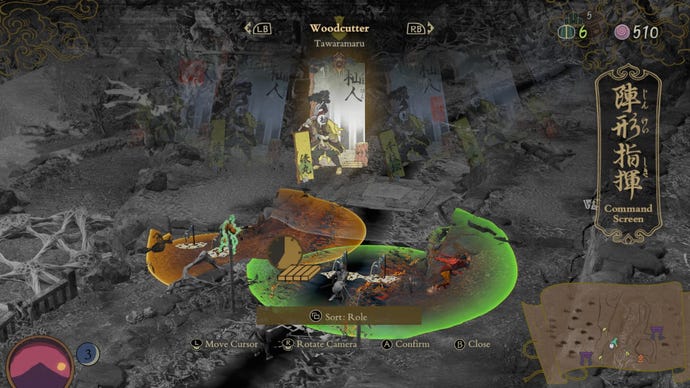
And that’s because of your role as Soh. In 90% of situations you’re required to get amongst it with your pals and harvest the orbs dropped by felled baddies. You can hack, slash, and with later upgrades, fire arrows and perform finishing moves to largely obliterate even the nastiest dribblers. Some might find it satisfying to contribute to the defence, and I certainly find my elevated strength in comparison to my pals fulfilled a power fantasy. But compulsory participation robs the game of the true joy of tower defence games, I reckon.
What is that joy? The joy of being a manager sat in a drone floating above the map, plopping some folks down and watching idly as they rinse the hordes. The joy, ultimately, of not really doing anything at all. With Kunitsu, you play a micromanager who constantly cleans up after a workforce who’s designed to do their job suboptimally. Rather than find it exciting to back up my pals, I honestly find it a bit exhausting.
Survive the night and it’ll transition to day, auto-burning any demons left on the map. And it’s here where you’ll spend all the orbs you’ve collected on either pushing Yoshiro further towards the endpoint, or – if that endpoint transitions into a second, more difficult gate chase – building up an entirely new set of defences and minions. If it ever launches me into a second gate chase, I’ll admit that a little part of my soul adopts the foetal position and rocks back and forth. Mainly because the day routine – orb collection, minion recruitment etc. – followed by the night portion further reinforces a repetitive loop that I simply can’t be bothered with.
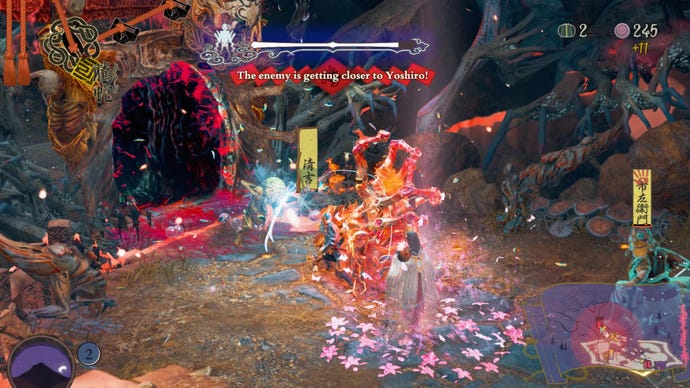
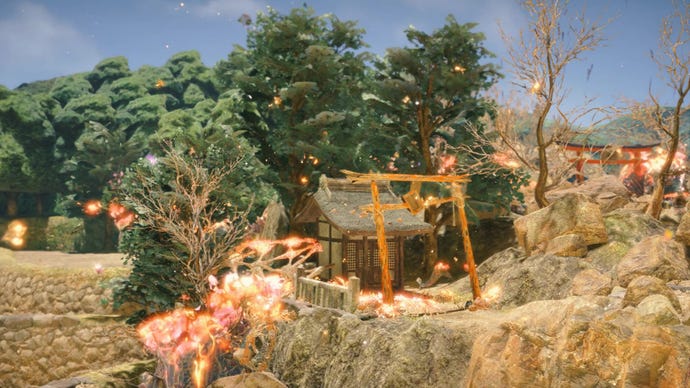
Occasionally the missions switch it up entirely, which is good! One time you’ve got several boats to defend as you float across a lake, while another time you’ve got some drums to bash, sending out area-of-effect spells with your beats. Ironically, though, the most fun I ever had was when the game transformed me into a spirit, who could only collect orbs and deposit them at Yoshiro – and who needed freeing from a demonic headcrab. The game finally let me command more minions and elevated them into a position of authority, pinning the responsibility on their performance rather than mine.
Boss fights let you unlock new types of pal, with the boss fights themselves against menacing demons with wonderfully horrible designs, like flailing centipedes and tormented buddhas who use prayer beads like knuckle dusters. Early fights are a bit repetitive, but that repetitiveness is shaken off later on for smart (if occasionally infuriating) scenarios that force you to split focus between boss-hitting and Yoshiro-aiding.
While it’s grand unlocking new minions, like shamans who heal or spear-wielders who sweep or ascetics who summon zones that slow enemies, I can’t help but feel they’re all a bit… eh. Enemy variety does force you into using different archetypes, and map layouts may change too, so you can’t go without experimentation. Yet their upgrades are a bit uninspiring (more health, more damage, a couple of better moves), which makes your investments feel more like you’ve poured your hard-earned cash into a Souls stat-sheet than I’d like.
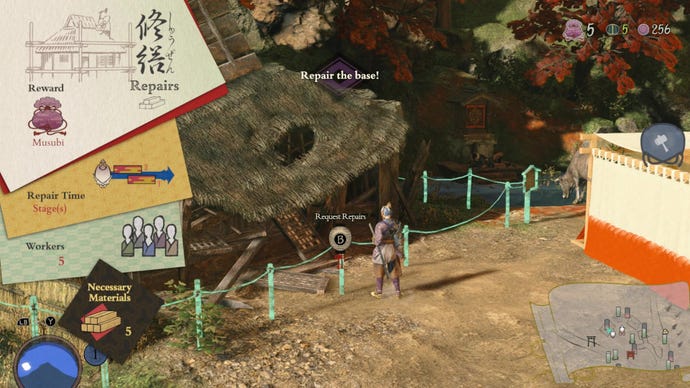
Complete an area – by both completing their associated tower defence and boss missions – and you’ll be able to revisit these cleansed areas as bases that you’ll need to repair. These act purely as currency-generators, granting you Musubi (used for upgrading your minions or Soh), orbs, and charms (which grant you special-ish abilities and stat boosts), should you successfully restore them to their former glory. While initially satisfying, these repair jobs aren’t a patch on DIY SOS and quickly become a mindless exercise. You assign villagers to repair spots, which take however many missions days to complete. Sometimes you ask villagers to pick up wood scattered around these bases before having them repair a more expensive, but more rewarding project. Then you return to these bases after each mission, collect your doodads, and rinse and repeat.
What do you get when you finally repair a base? No interactions with the villagers, no little “Cheers mate” from Yoshiro, nothing but a little more currency. At least Nick Knowles got to chat with the builders and families after doing up their houses.
I do think it’s great that Capcom have released a weird, sometimes wonderful tower defence/ action RPG hybrid with such strong early-millennium vibes. And I think some will find its micromanagement more compelling than I did, with base repairs and the gradual power climb forming an easy way to spend an evening with an average-to-good video game. And yet, I also think many will find its take on tower defence only half-delivers. It might be full of distinct elements that often work together, be they base-building or hack ‘n’ slashing, but as a whole, it falls into a repetitive rhythm that struggles to capture the joys and thrills of much simpler tower defence games.
This review is based on a review build of the game provided by the developer.
